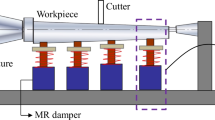Abstract
To solve the problem of processing quality degradation due to vibration in the robot bonnet polishing system (RBPS), the vibration generation mechanism of the polishing system is revealed based on the modal analysis and dynamic modeling of the RBPS. The modal analysis results showed that the operating frequency of the system is near the natural frequency, which makes the system susceptible to resonance. On the other hand, the forced vibration caused by the polishing force leads to high vibration at the end of the robot during the polishing process. In order to suppress the vibration generated by the polishing system and optimize the dynamic characteristics of the polishing system, a vibration suppression method to increase the damping ratio of the system was proposed. The experiments of SiC fixed point polishing were performed using both vibration suppression bonnet and original bonnet. The surfaces RMS and PV of the parts polished by the vibration suppression bonnet were generally better than those of the original bonnet. The vibration suppression bonnet has improved the convergence ratio of RMS and PV by 42.59% and 19.56% respectively over the original bonnet in the whole surface polishing experiments. The PSD analysis illustrated that the vibration suppression bonnet can better suppress the intermediate frequency errors. The effectiveness of the method in suppressing vibration and improving machining quality is demonstrated.























Similar content being viewed by others
References
Walker D, Brooks D, King A, Freeman R, Kim SW (2003) The ‘Precessions’ tooling for polishing and figuring flat, spherical and aspheric surfaces. Opt Express 11(8):958–964
Pan R, Zhang YJ, Cao C, Sun M, Wang ZZ, Peng YF (2015) Modeling of material removal in dynamic deterministic polishing. J. Adv. Manuf. Technol. 81(9-12):1631–1642
Beaucamp A, Namba Y, Charlton P (2014) Corrective finishing of extreme ultraviolet photomask blanks by precessed bonnet polisher. Biomed. Opt. Express 53(14):3075
Wang W, Yu G, Xu M, Walker D (2014) Coordinate transformation of an industrial robot and its application in deterministic optical polishing. Opt. Eng. 53
Walker D, Yu GY, Gray C, Rees P, Bibby M, Wu HY, Zheng X (2016) Process automation in computer controlled polishing. Adv. Mater. Res. 4231
Moradi H, Bakhtiari-Nejad F, Movahhedy MR (2008) Tuneable vibration absorber design to suppress vibrations: an application in boring manufacturing process. J. Sound Vib. 318(1-2):93–108
Yuan L, Pan Z, Ding D, Sun S, Li WM (2018) A review on chatter in robotic machining process regarding both regenerative and mode coupling mechanism. IEEE ASME Trans Mechatron 23(5):2240–2251
Guo YJ, Dong HY, Wang GF, Ke YL (2016) Vibration analysis and suppression in robotic boring process. Int. J. Mach. 101:102–110
Guo YJ, Dong HY, Ke YL (2015) Stiffness-oriented posture optimization in robotic machining applications [J]. Robot Comput Integr Manuf 35:69–76
Li J, Li B, Shen NY, Qian H, Guo ZM (2016) Effect of the cutter path and the workpiece clamping position on the stability of the robotic milling system [J]. J. Adv. Manuf. Technol.:1–15
Li J, Li B, Qian H, Shen NY (2016) The design of manipulator to grab wheel hub based on static and dynamic analysis [C]. IWAMA
Li Y (2014) Research on adaptive backstepping sliding mode control and vibration suppression for a rigid-flexible manipulator [D]. Jilin University
Chen F, Zhao H, Li D, Chen L, Tan C, Ding H (2019) Contact force control and vibration suppression in robotic polishing with a smart end effector. Robot Comput Integr Manuf 57:391–403
Sun L, Zheng K, Liao W, Liu J, Dong S (2020) Investigation on chatter stability of robotic rotary ultrasonic milling. Robot Comput Integr Manuf. 63:101911
Wang Q, Wang W, Zheng L, Yun C (2021) Force control-based vibration suppression in robotic grinding of large thin-wall shells. Robot Comput Integr Manuf. 67:102031
Patrizi N, Fragkos G, Ortiz K, Oishi M, Tsiropoulou EE (2021) Research on an evaluation model for the working stiffness of a robot-assisted bonnet polishing system [J]. J. Manuf. Process. 65:134–143
Jiao EZ, Chen MH (2010) Study on velocity simulation and jacobian matrix solution of 6R serial robots [J]. Machine Tool & Hydraulics 09:116–119
Pan R, Zhao WY, Zhong B, Chen DJ, Wang ZZ, Zha CQ, Fan JW (2019) Evaluation of removal characteristics of bonnet polishing tool using polishing forces collected online [J]. J Manuf Process 47(Nov.):393-401
Pan R, Zhong B, Chen DJ, Wang ZZ, Wei SN (2018) Modification of tool influence function of bonnet polishing based on interfacial friction coefficient. Int J Mach Tools Manuf 124:43-52
Fang Q, Li C, Fei SH, Meng T (2016) Stability analysis of robot boring system [J]. Acta Aeronaut. Astronaut. Sin. 37(2):727–737
Wu WM (2019) Study on the stiffness and damping characteristics of annular rubber-silicone oil damper [D]. Nanjing University of Aeronautics and Astronautics
Data availability
We declare that some of the data of this study are available within the article.
Code availability
Not applicable.
Funding
This work was financially supported by the National Natural Science Foundation of China (Grant No. 51705011 and 52075462), and the Scientific and Technological Project of Quanzhou (Grand No. 2022C004).
Author information
Authors and Affiliations
Contributions
Ri Pan, Jinwei Fan, and Zhenzhong Wang were responsible for the formulation of the overall plan. Chunfu Hu prepared the manuscript. Feng Lu and Xuepeng Huang assisted all the experiments.
Corresponding author
Ethics declarations
Ethics approval
Not applicable.
Consent to participate
Not applicable.
Consent for publication
We agree to transfer copyright of this article to the Publisher.
Conflict of interest
The authors declare no competing interests.
Additional information
Publisher’s note
Springer Nature remains neutral with regard to jurisdictional claims in published maps and institutional affiliations.
Rights and permissions
Springer Nature or its licensor (e.g. a society or other partner) holds exclusive rights to this article under a publishing agreement with the author(s) or other rightsholder(s); author self-archiving of the accepted manuscript version of this article is solely governed by the terms of such publishing agreement and applicable law.
About this article
Cite this article
Pan, R., Hu, C., Fan, J. et al. Study on optimization of the dynamic performance of the robot bonnet polishing system. Int J Adv Manuf Technol 125, 4561–4577 (2023). https://doi.org/10.1007/s00170-023-10998-x
Received:
Accepted:
Published:
Issue Date:
DOI: https://doi.org/10.1007/s00170-023-10998-x




